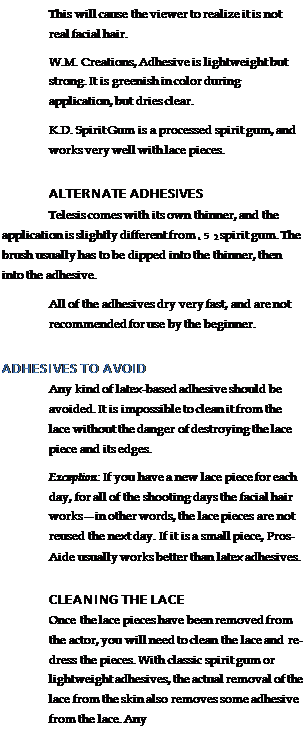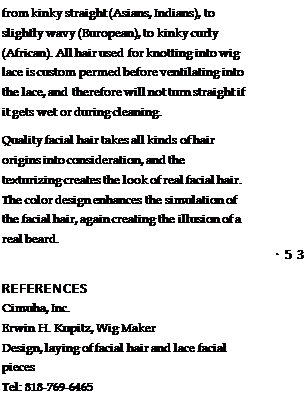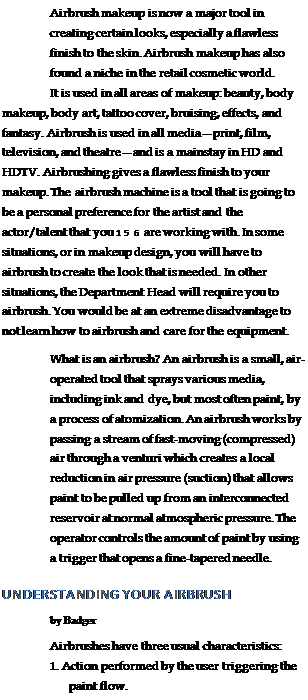For stubble looks by hand, you can choose to use a medium-sized makeup brush or a small atomizer, with a matte spirit gum adhesive or beard stipple wax by KRYOLAN. We will show you this technique using the makeup brush and stipple wax. The wax is clear on the skin no matter what skin tone, and has no shine whatsoever. This is a huge advantage for HD and close-up work. If you use spirit gum, we recommend W. M. Creations, Extra Hold Matte Adhesive. Blend and prep your hair using at least two colors of hair.
Lay white facial tissue on your workstation or counter.
Wet your hair with a small amount in your hand. Hold over the tissue, making uniform cuts to the hair, so that the chopped hair drops onto the tissue.
Let the chopped hair dry on the tissue.
Remember, it is best to cut the hair when wet, and to take care making each cut the same size.
There is a tendency to make your cuts too long. Look at your first cut of hair to check length. Hair needs to be completely dry before being applied to the face.
Apply beard stipple wax over the beard area of the face where you want to apply hair.
With a clean, medium-sized makeup brush, pick up the desired amount of chopped hair from the tissue by dipping the brush into the hair on the tissue.
Using a quick, light motion with the end of the brush, apply at a slant to the beard area. The quick hand motion, or stipple, needs to barely touch the skin to create a raised beard area. If you hit the brush with too much pressure, the hair will stick flat. It helps to have a bit of static electricity in the makeup brush. You can get static in your brush by rubbing the brush quickly back and forth over a towel.
Go back with a small, stiff brush or tweezers, and lift any hair that is not sticking out straight. You do not want any hairs to be laying flat against the skin.
Sometimes there can be clumps or patterns that you will need to thin out.
Be gentle. This application is fragile, but easily touched up.
Remember, with all hair applications, to stand back and really look at your work, as well as getting up close to the skin and checking. Check your work in the makeup mirror from all angles, by rotating the actor around.
If you believe it up close, so will the camera.
In film, television, and HD, use only matte adhesive. The application is very important because any shine or glow from the adhesive under the lace piece will register.

![]() adhesive left on the lace can be removed by the following steps:
adhesive left on the lace can be removed by the following steps:
1. In a saucer or plate filled with the cleaning agent about 1/2 inch deep, lay the pieces in the solution with the lace facing down (hair up). Try not to have the hair covered entirely by the cleaning solution. Let it set for one to two minutes. The heavier the adhesive, the longer it needs in the cleaning bath.
2. Lay the piece on a towel, but try to avoid pressing the hair flat.
3. Dip the brush into the cleaning agent, and brush out any leftover adhesive from the lace.
4. Important: Always follow the direction of the knotting on the lace. Example: On a mustache, brush from the nostrils down to the upper lip.
Very important: Never brush against the knotting. This results in opening the knotted hair, and the knots wll appear larger and eventually fall out.
5. After the entire adhesive is removed, place the pieces on a clean towel and let evaporate for 10 to 20 minutes.
The pieces are ready for blocking and any re-dressing.
The cleaning agent is different, depending on the glue and/or adhesive being used:
Classic Spirit Gum: Easy cleaning with a mix of 99 percent alcohol and acetone (1 : 1 ratio).
Matte Adhesives: 99 percent alcohol.
Silicone-Based Adhesives: Use special cleaner that often has a slight oil base in it. Lay the facial hair in alcohol after using these cleaners, and let soak for a few minutes to dissolve the oil. Remove, do not comb, and let dry without stretching the lace, on a clean towel. After the facial hair is completely dry, it can be re-dressed.
Latex-Based Adhesives: Need a heavy oil and alcohol mix. Try a mix of baby oil and alcohol (1 : 1 ratio).
A stiff bristle brush is used to brush off the residue of the latex—this is labor-intensive.
Beard Stubble Wax: Cannot be used with lace pieces as an adhesive. It is a tacky wax paste, and the lace hairpiece would not successfully stay on.
 All facial hair needs to be texturized before applying it to the face. The texture varies
All facial hair needs to be texturized before applying it to the face. The texture varies

![]()
2. The mechanism for feeding the paint into the airbrush.
3. The point in which the pressure (PSI) and air mix. (PSI means measurement of air pressure, pounds per square inch.)
There are two different ways an
airbrush mixes with paint, allowing you to
airbrush:
Internal Mix: The paint and the air mixes together inside the head assembly to produce a thoroughly atomized fine-dot spray pattern.
External Mix: Indicates that air and paint mix outside the airbrush. Air and paint come together outside the head, or fluid assembly. External-mix airbrushes produce a larger-dot spray pattern than internal-mix airbrushes.
